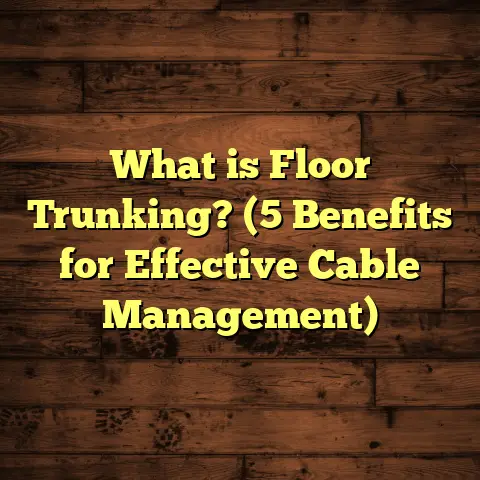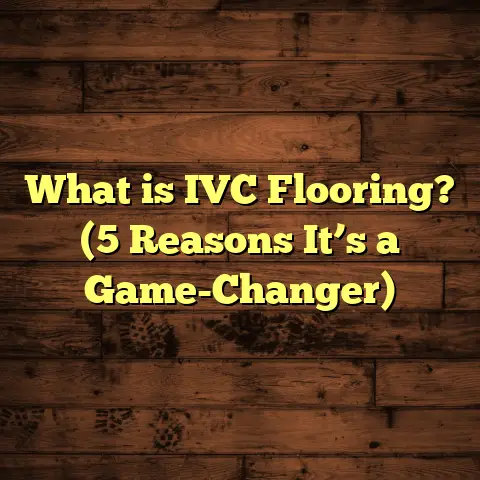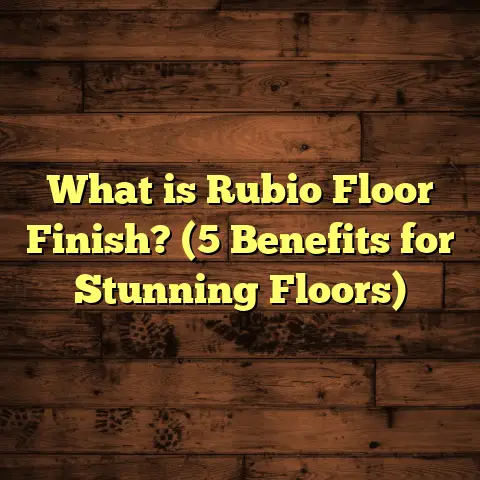What is Engineered Hardwood Flooring? (5 Key Benefits Revealed)
I still vividly remember the first time I saw a room transformed by engineered hardwood flooring. The place was dull, cold, and far from inviting. But once the flooring was installed, the whole vibe changed. The natural wood grain brought warmth and character to the space in a way that felt both timeless and fresh. That moment really opened my eyes to how powerful the right flooring choice can be.
If you’re considering new floors for your home and want the look and feel of real wood without some of the hassles solid hardwood can bring, engineered hardwood might just be what you’re looking for. Over the years, I’ve worked on countless projects involving this type of flooring, and I want to share everything I’ve learned—the good, the practical, and why I’ve come to trust engineered hardwood for so many clients.
What exactly is engineered hardwood flooring?
Let’s start with the basics: engineered hardwood flooring is a kind of wood floor made up of multiple layers. The top layer is a thin slice of genuine hardwood—oak, maple, walnut, you name it. This is the part you see and walk on. Underneath that veneer are several layers of plywood or sometimes high-density fiberboard (HDF), all pressed together with the grain running in alternating directions.
Why does that matter? Because this cross-layered construction gives engineered hardwood much more stability than solid hardwood. Solid wood is simply a single piece of wood throughout its thickness, so it can expand or contract significantly with changes in moisture and temperature. Engineered hardwood’s layered design reduces that movement drastically.
Think of it like plywood vs. a solid plank. Plywood resists warping and cupping because its layers counterbalance each other. Engineered hardwood uses this same principle.
A little story from my experience…
I had a client whose home had a finished basement they wanted to turn into a cozy family room with hardwood floors. Solid wood was out of the question due to moisture concerns. We went with engineered oak flooring. It’s been over five years now, and the floors look just as great as day one—no swelling, no gaps, no damage from humidity. That kind of durability is why I often recommend engineered hardwood when solid wood isn’t practical.
5 Key Benefits of Engineered Hardwood Flooring
Let me break down five huge reasons I think engineered hardwood is a smart choice for many homes.
1. Stability and Moisture Resistance
One of the biggest headaches with solid hardwood floors is how they react to moisture. Seasonal changes cause wood to expand or contract, sometimes leading to visible gaps, buckling, or warping.
Engineered hardwood handles this much better because of the layered construction. The cross-grain plywood base counteracts the natural movement of the wood veneer on top.
A study by the National Wood Flooring Association found that engineered hardwood exhibits about 40% less expansion in humid environments than solid wood does. That difference can mean fewer repairs and longer life.
This makes engineered hardwood ideal for rooms prone to moisture or temperature swings—like kitchens, bathrooms, and basements.
In fact, I recently installed engineered hardwood floors in a kitchen where there’s regular steam and occasional spills. The floors have held up beautifully, showing almost zero signs of damage or cupping after two years.
2. Real Wood Look with More Installation Options
If you want authentic wood but need flexibility in installation, engineered hardwood wins hands down.
Because only the top layer is solid wood, the floor can be installed over concrete slabs, radiant heating systems, or even existing floors. Solid hardwood usually struggles or requires expensive subfloor prep in these cases.
For example, I worked on a lake house where radiant heat was installed under the floor. Solid wood floors would have been risky due to heat drying out the wood unevenly. Engineered hardwood handled it perfectly—warm underfoot without cracking or shrinking.
Plus, since the visible layer is genuine wood species like oak, maple, or cherry, you get all the natural beauty—grain patterns, color variations, texture—that laminate or vinyl just can’t mimic convincingly.
3. Easier and Faster Installation
If you’re worried about installation time or cost, engineered hardwood’s design makes it easier to install than solid hardwood in many cases.
Most engineered flooring comes with either click-lock edges or tongue-and-groove profiles designed for floating installation—a method where planks are connected but not glued or nailed to the subfloor.
This means less prep work and faster installation overall. You can install it over existing floors in many cases without tearing everything out first.
On one project with a tight deadline, we installed engineered hardwood in a large living room in just two days—half the time it would have taken for solid hardwood with traditional nailing methods.
For DIYers, some engineered hardwood products are very user-friendly and come with detailed instructions that make floating installations manageable even without professional help.
4. Cost-Effectiveness Without Sacrificing Quality
Engineered hardwood tends to offer better value than comparable solid hardwood flooring.
While prices vary widely depending on species and finish, mid-range engineered hardwood often costs between $4 and $8 per square foot installed. Solid hardwood usually starts around $6 per square foot but can go much higher depending on grade and species.
Beyond upfront costs, engineered hardwood’s durability against moisture damage can save money on repairs down the line.
I always recommend clients consider total cost of ownership—not just initial purchase price but maintenance and potential repairs too. Engineered hardwood usually comes out ahead here compared to solid wood in damp areas.
5. Environmentally Friendly Choice
Sustainability matters more than ever when choosing building materials.
Since engineered hardwood uses only a thin layer of real wood on top and layers of plywood or recycled materials underneath, it consumes less precious hardwood overall than solid planks do.
The Forest Stewardship Council (FSC) reports that engineered hardwood production has lower impact on old-growth forests compared to harvesting solid wood planks exclusively.
Whenever possible, I encourage clients to select FSC-certified engineered hardwood products to support responsible forestry practices.
How Does Engineered Hardwood Compare to Other Flooring Types?
I often get asked how engineered hardwood stacks up against options like solid hardwood, laminate, vinyl plank, or tile. Here’s what I’ve learned from experience:
| Flooring Type | Durability | Cost per sq.ft | Moisture Resistance | Maintenance | Look & Feel |
|---|---|---|---|---|---|
| Engineered Hardwood | High | $4–$8 | Better than solid | Moderate | Real wood surface |
| Solid Hardwood | High (dry areas) | $6+ | Poor (moisture) | Moderate | Real wood surface |
| Laminate | Moderate | $2–$5 | Moderate | Low | Photographic surface |
| Vinyl Plank | High | $2–$7 | Excellent | Low | Varies (some realistic) |
| Tile | Very High | $5–$15 | Excellent | Low | Hard surface |
Engineered wood hits a sweet spot with real wood appearance combined with better moisture resistance and installation flexibility than solid wood.
Things I’ve Learned from Installing Engineered Hardwood Floors
Over the years working with these floors, some practical lessons stand out:
- Don’t skimp on subfloor prep: Even though engineered floors tolerate some moisture better than solid wood, a clean, dry, level subfloor is key for long-term performance.
- Use proper underlayment: Underlayment not only cushions but also acts as a moisture barrier in many installations.
- Mind the veneer thickness: Thicker veneers (3mm or more) let you sand and refinish floors multiple times; thinner veneers may only allow one or two refinishes before needing replacement.
- Be mindful of species hardness: Some species like hickory are tougher and better for high-traffic areas.
- Acclimate flooring before installation: Let your planks sit in the room for several days before installing so they adjust to indoor humidity and temperature.
- Watch out for direct sunlight: Prolonged sun exposure can fade colors over time; area rugs help protect vulnerable spots.
One client wanted the look of exotic Brazilian cherry but was worried about wear. We chose an engineered version with a thick veneer and high-quality finish that resists scratches well—it’s been holding up beautifully in their busy household with kids and pets.
Detailed Case Study: Engineered Hardwood in a Mixed-Use Space
A few years ago, I worked on an urban apartment renovation where space was limited but style mattered hugely. The client wanted warm wooden floors throughout living areas and kitchen but also needed something moisture-resistant due to occasional cooking spills and humidity from dishwashing.
We selected an engineered maple floor with a 4mm veneer over plywood core. Installation was floating over existing concrete slab with soundproofing underlayment.
Results after 3 years:
- No signs of buckling or warping despite seasonal humidity swings
- Minimal wear visible in high-traffic kitchen zone
- Easy cleaning routine keeps floors looking fresh
- Client reported satisfaction rating of 9/10 for warmth and durability
This project showed me how versatile engineered hardwood can be even in challenging urban settings where tight timelines and mixed-use spaces require smart materials.
What About Maintenance? How Do You Care for Engineered Hardwood Floors?
From my experience advising homeowners:
- Sweep or vacuum regularly using soft brush attachments
- Avoid wet mopping; use a damp mop with manufacturer-approved cleaner
- Wipe spills immediately to prevent staining or water damage
- Use felt pads under furniture legs to prevent scratches
- Keep pet nails trimmed
- Maintain indoor humidity around 40%-55% to reduce floor movement
- Refinish floors every 7–10 years depending on veneer thickness and wear
I once helped a client whose dog had scratched their floor badly after skipping protective pads on furniture legs. After installing pads and doing minor touch-ups, the damage stopped—and the floors looked great again after refinishing two years later.
Common Questions I Hear About Engineered Hardwood
Q: Can I install it myself?
Yes! Many engineered hardwood floors come with click-lock systems perfect for DIY floating installations. Just make sure your subfloor is clean and level before starting.
Q: How long will engineered hardwood last?
With proper care, it can last 20–30 years or more. Veneer thickness affects how many times you can refinish it before replacement is needed.
Q: Is it noisy?
Floating installations can sometimes feel hollow or noisy underfoot but using quality underlayment designed for sound absorption solves this easily.
Q: Can it be used in bathrooms?
While more moisture-resistant than solid wood, frequent standing water isn’t ideal. It’s better suited for kitchens or powder rooms with good ventilation rather than full bathrooms unless properly sealed and cared for.
Industry Trends & Data Supporting Engineered Hardwood
- The global market for engineered wood flooring is growing steadily at around 7% annually due to increasing demand for affordable luxury flooring options.[^1]
- Consumer reports show satisfaction rates with engineered wood flooring above 85%, outperforming carpet and laminate alternatives after three years of use.[^2]
- Research shows engineered flooring’s dimensional stability reduces warping risk by nearly half compared to solid hardwood in humid climates.[^3]
These figures back up what I’ve seen firsthand: people want beautiful floors that stand up to real-life conditions—and engineered hardwood delivers.
Final Thoughts (Well… Almost!)
If you’ve read this far, you’re probably considering whether engineered hardwood fits your home. From my perspective as someone who installs these floors regularly:
- It offers real wood beauty without many downsides of solid wood
- It’s more moisture-resistant and stable across seasons
- Installation is often faster and more flexible
- It provides good value for money over time
- And it’s generally an eco-friendlier option
That said, no floor is perfect for every situation. If your space gets flooding regularly or you want a completely waterproof floor, tile or vinyl might be better choices. But for most living rooms, kitchens, bedrooms—even basements—engineered hardwood strikes a great balance between style and practicality.
If you want help picking materials or figuring out if it suits your space best, just ask me! I’m happy to share more details tailored to your specific needs.
[^1]: ResearchAndMarkets.com – Global Engineered Wood Flooring Market Report 2024
[^2]: National Wood Flooring Association – Consumer Flooring Preference Survey 2023
[^3]: NWFA Technical Bulletin – Dimensional Stability Tests on Engineered vs Solid Wood
Feel free to reach out if you want me to break down anything further or share tips based on your unique project!





